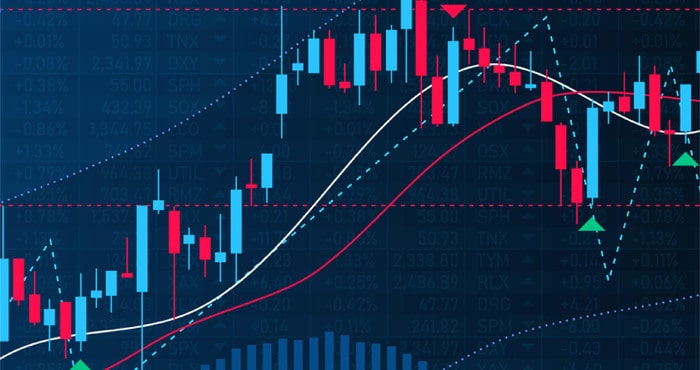Chapter 5 - Introduction to fundamental analysis
Lesson 5.4 - Economic Indicators - Inflation Rates

What Is Inflation?
Inflation is an increase in the price level of goods and services that homes buy. It is measured as the rate at which these prices change. Usually prices increase over time, but prices can also decrease (a condition called deflation).
The most popular indicator of inflation is the Consumer Price Index (CPI), which measures the percentage of change in the price of a basket of goods and services consumed by homes.
In Australia, the Consumer price index (CPI) is calculated by the Australian Bureau of Statistics (ABS) and is published once every three months. To calculate the CPI, ABS collects prices for thousands of items, which are grouped into 87 categories (or spending categories) and 11 groups. Each quarter, ABS calculates changes in the price of each element from the previous quarter and adds them to find the inflation rate for the entire CPI basket.
How Can Inflation Be Calculated?
For example:
To better understand how inflation is calculated, we can use an example. In this example, we calculate inflation for a basket with two items therein - books and childcare.
Book price was $ 20 in 2016 (year 1) and this price increased to $ 20.50 in 2017 (year 2). The childcare hour was estimated by $ 30 in 2016, and this rate increased to $ 31.41 in 2017.
For books, the annual inflation was 2.5%.
For childcare, the annual inflation rate was 4.7%
To calculate inflation for a basket that includes books and childcare, we need to use CPI weights that are based on how much households spend on these items. Since families spend more on caring for children than books, childcare has a lot more weight in the basket. In this example, childcare represents 73 % of the basket, and books account for the remaining 27%. Using these weights, and the change in item prices, the annual inflation rate for this basket was 4.1% - calculated by (0.73 x 4.7) + (0.27 x 2.5).
How Are Prices Collected?
The Australian Bureau of Statistics collects prices from a wide range of sources, such as retailers, supermarkets, department stores, and locations where families shop. It also collects prices from government authorities, energy providers, and real estate agents. For some elements, ABS has access to the data that allows it to record prices frequently. For example, scanner data from supermarkets provide information about the price and number of items a consumer purchases in a single transaction. For other items, ABS records prices monthly, quarterly or annually. In total, ABS collects about 100,000 prices every three months.
Historical Examples of High Inflation:
Historically, rapid increases in the amount of money or total money supply have occurred in many different societies throughout history, and have changed with different forms of money used.
For example, when gold is used as a currency, the government can collect, melt, and mix gold coins with other metals such as silver, copper, or lead, and reissue them at the same face value. By diluting gold with other metals, the government can issue more coins without increasing the amount of gold used to make them. When the cost of each currency is reduced in this way, the government benefits from an increase in its disposal. This practice will increase the money supply, but at the same time, the relative value of each currency will be reduced. As the relative value of coins decreases, consumers will need to give more coins for the same goods and services than before. These goods and services will witness an increase in prices as each currency is devalued.
The Song Dynasty of China introduced the practice of printing paper money to create a fiat coin. During the Mongolian Yuan Dynasty era, the government spent a great deal of money fighting expensive wars, and it reacted by printing more money, which led to inflation. Fearing the inflation inflicted on the Yuan Dynasty, the Ming Dynasty initially refused to use paper money and returned to using copper coins.
Historically, the pumping of large amounts of gold or silver into the economy has led to inflation. From the second half of the fifteenth century to the first half of the seventeenth century, Western Europe experienced a massive inflationary cycle referred to as the "price revolution", with prices rising on average perhaps sixfold in 150 years. This was largely due to the sudden influx of gold and silver from the New World to Habsburg, Spain. Silver has spread throughout previously cash-hungry Europe and caused widespread inflation.
Demographics also contributed to the pressure on prices, with European populations growing after a population decline due to the Black Death epidemic.
By the nineteenth century, economists had classified three separate factors that cause an increase or fall in the price of a commodity: A change in the value of the commodity or its production costs, a change in the price of money that was usually a fluctuation in the commodity because of the price of the metal content in the currency, and a the decrease in the value of the currency resulting from an increase in the supply of currency relative to the amount of recoverable metal that supports the currency. In the wake of the proliferation of the special banknotes printed during the American Civil War, the term "inflation" began to appear as a direct reference to the currency devaluation that occurred as the amount of recoverable banknotes exceeded the amount of metal available for recovery. At the time, the term “inflation” refers to a depreciation of a currency, rather than a rise in commodity prices.
Former classical economists such as David Hume and David Ricardo have observed this relationship between excessive supply of banknotes and the resulting devaluation, and they went on studying and discussing the effect of devaluation (later called cash inflation). on the price of goods (price inflation later, and eventually just inflation).
The adoption of the Fiat currency "compulsory cash" by many countries, since the eighteenth century onwards, made the differences much larger in the money supply. Rapid increases in the money supply occurred several times in countries suffering from political crisis, which led to hyperinflation. The hyperinflation episodes are much higher than those observed in earlier periods of commodity funds. An example of this, take the hyperinflation in the German Weimar Republic. Currently, Venezuela’s hyperinflation is the highest in the world, with an annual inflation rate of 833,997% as of October 2018.
However; Since the 1980s, inflation has remained low and stable in countries with strong and independent central banks. This has led to a moderation in the business cycle and reduced variation in most macroeconomic indicators, an event known as the Great Equinox.
- Inflation is classified into three types: Demand-pull inflation, cost - push inflation, and built- in inflation.
- The most common inflation indicators are the Consumer price index (CPI) and the Wholesale Price Index (WPI).
- Inflation can be viewed positively or negatively according to the individual perspective.
- Owners of tangible assets, such as property or stored goods, may want to see some inflation because this increases the value of their assets.
- People who hold cash may not like inflation, because it weakens the value of their cash holdings.
- Ideally, the optimal level of inflation is needed to encourage spending somewhat instead of saving, thus fostering economic growth.


 English
English





